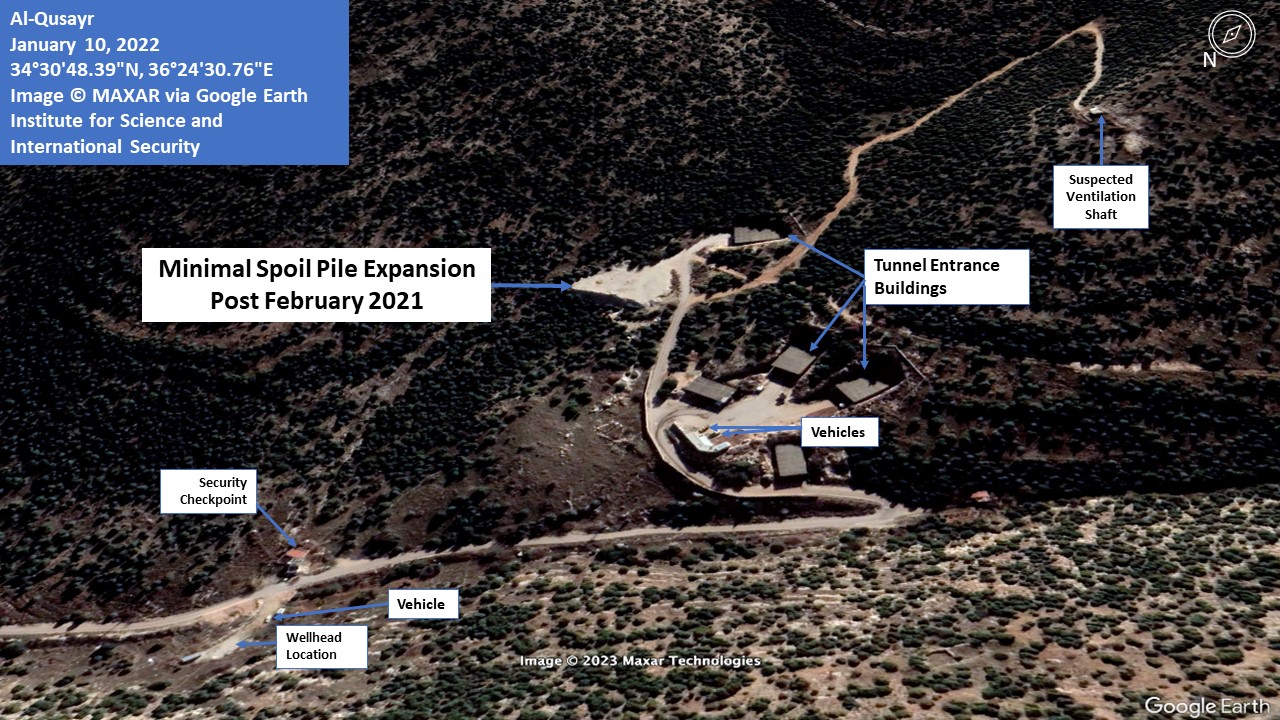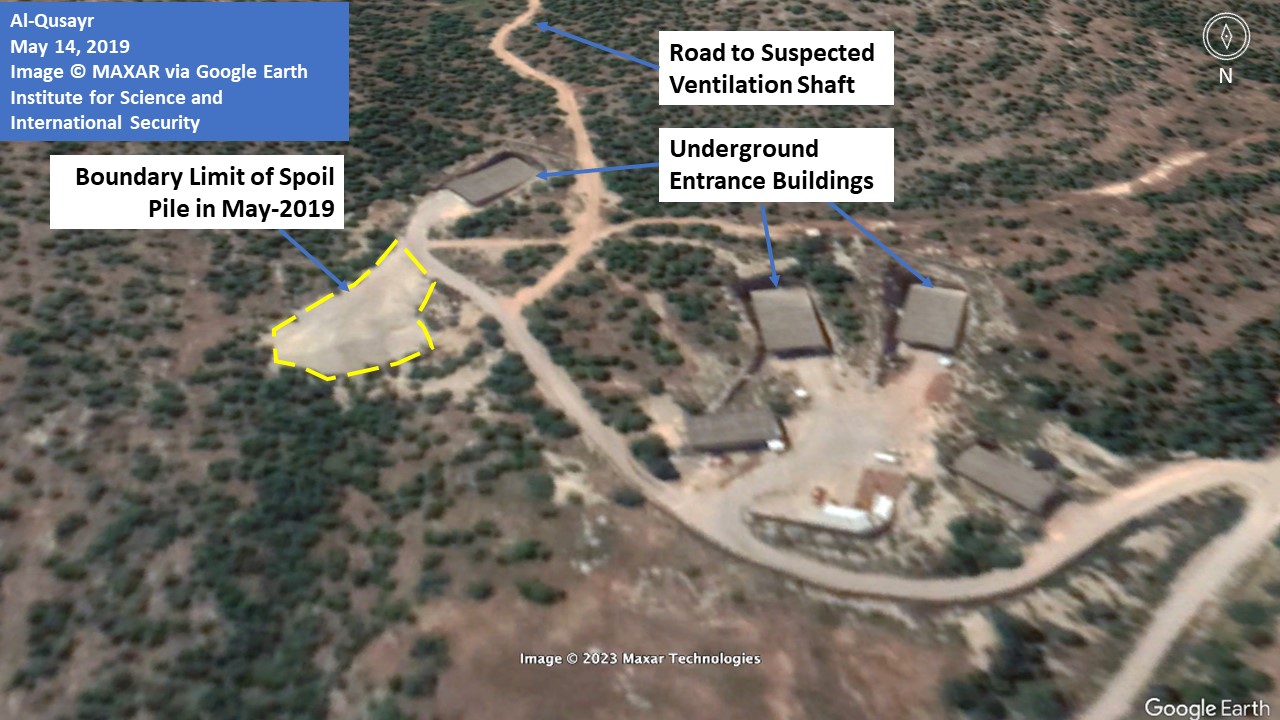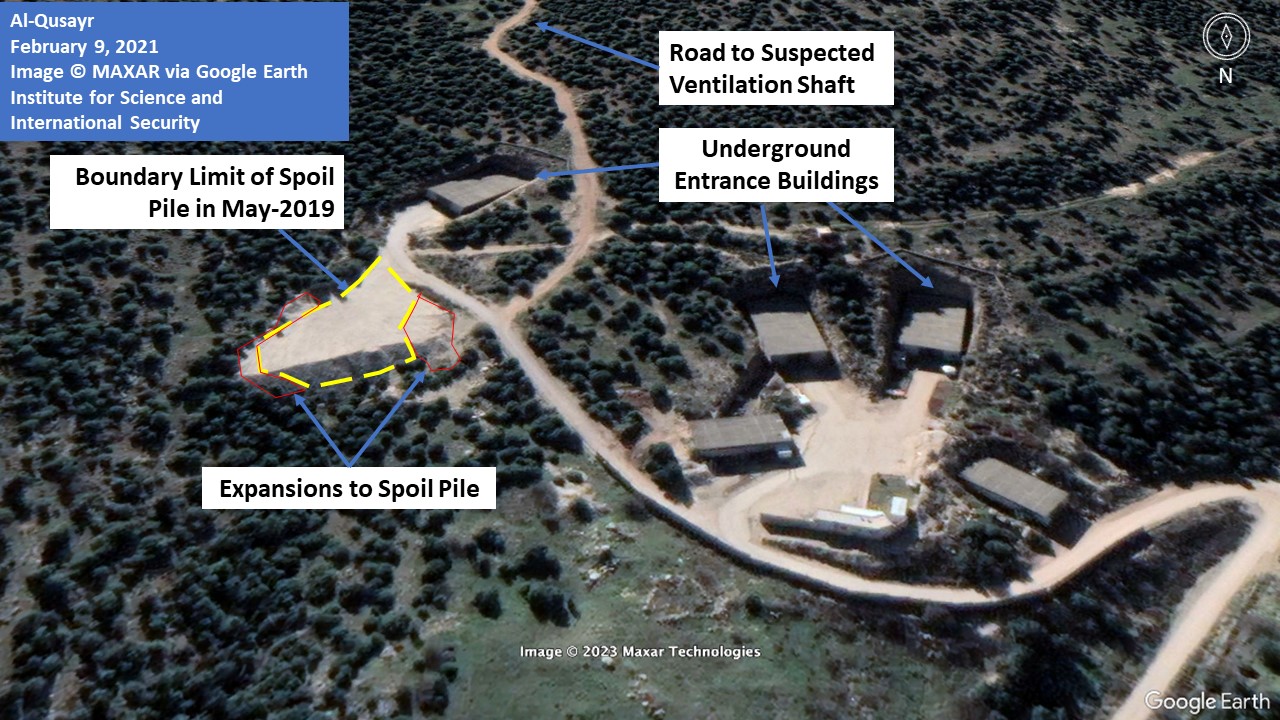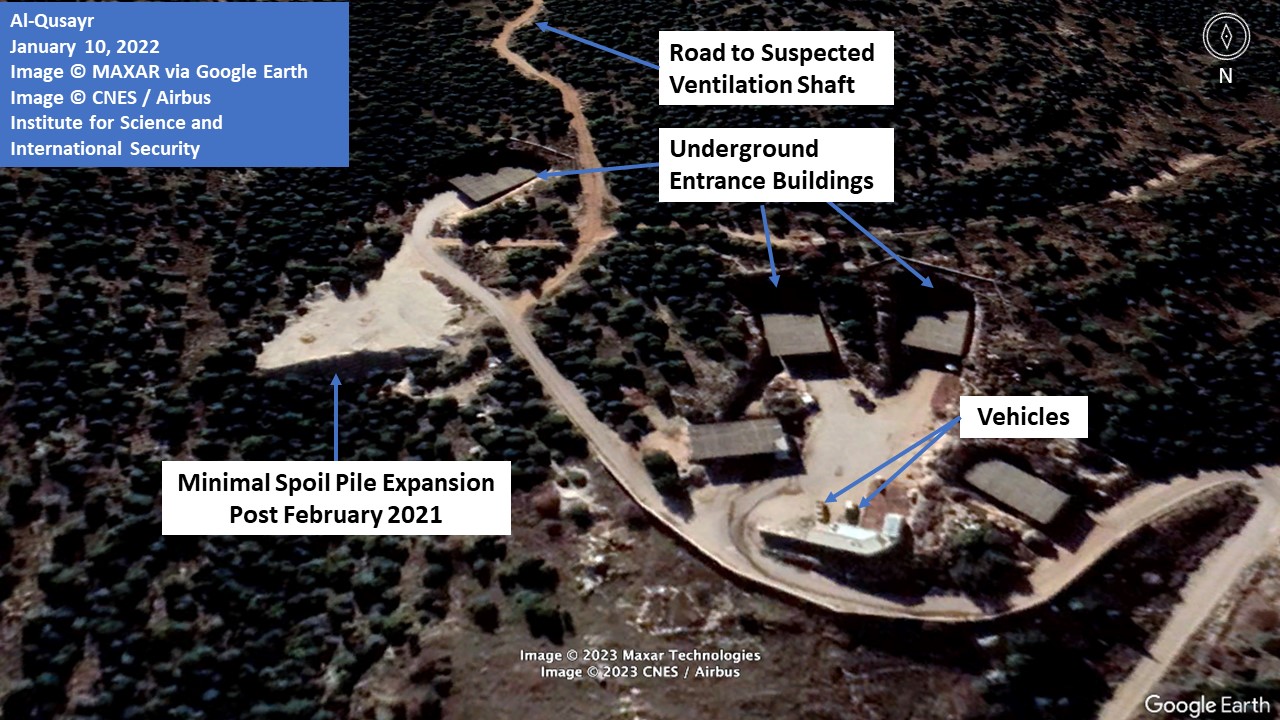Reports
Continued Activity Identified at Al-Qusayr, Syria
by David Albright, Sarah Burkhard, Spencer Faragasso
April 12, 2023
Background
Al-Qusayr is a suspected underground military and possibly nuclear-related facility located in Syria, near the border with Lebanon.
In the past, efforts were made to conceal the construction of the tunnel facility.
The tunnel facility is suspected to have three tunnel entrances concealed by buildings.
The site maintains a low security profile with only a single observable checkpoint on the main road leading towards the facility and no visible fenced security perimeter.
Support infrastructure includes a known well onsite located above a substantial aquifer, an incoming low voltage powerline, and a suspected ventilation shaft located above the underground area.
While a military or even a nuclear related-purpose is possible, the true purpose of the site remains unconfirmed. A nuclear reactor or uranium enrichment plant have been posited for the site, but such plans would be a major engineering challenge and require extensive foreign assistance.
As the site remains a possible nuclear site, it remains of interest to the Institute to monitor changes at the site.
Key Findings
The site remains active, with evidence of increased underground excavation during 2019 through 2020.
The spoil pile adjacent to the eastern tunnel entrance has visibly grown in size since the last Institute analysis in 2018.
The visible movement of vehicles around the site, including cars and trucks, as well as vehicle tracking are additional indicators of ongoing activity at this site.
No new major above-ground structures have been built, at least as evident in available satellite imagery between January 2019 and January 2022.
Introduction
The Institute first analyzed the Syrian Al-Qusayr site, located near the border with Lebanon, in 2018, following a report by Der Spiegel in 2015, citing “foreign intelligence agencies” that Al-Qusayr is a secret underground nuclear facility that could contain nuclear material storage (fuel rods), and possibly a nuclear reactor or nuclear enrichment plant. 1
The Institute conducted two consecutive analyses in March 2 and September 3 of 2018 and was unable to confirm that the site served a nuclear related function or could house a nuclear reactor. An underground nuclear reactor in Syria would require extensive foreign assistance and would pose a significant engineering challenge. One reason why the site attracted the Institute’s attention was the apparent effort put into hiding the excavation efforts; usually, large tunnel constructions can be easily spotted in satellite imagery due to large spoil piles and visible tunnel portals leading into the mountain. At Al-Qusayr, however, spoil piles were camouflaged on the side of a nearby hill and near the main road, and tunnel portals were hidden by buildings situated at the foot of the mountain. A conventional military related function is more plausible, but unconfirmed due to the limited information available on the site. In 2012, a separate publication, IHS Jane’s identified it as a SCUD missile site.
Another feature that drew the Institute’s attention was a mobile drilling operation at the site in 2012, and hydrologic maps of the area that show a substantial near surface aquifer that could provide water for underground facility cooling. 4
Continued Activity: The Spoil Pile Grows
The Institute has reviewed satellite imagery of the site, where available imagery on Google Earth is sufficient in resolution and temporal frequency to monitor changes from January 2019 to January 2022. A new phase of underground excavation was apparent between mid-2019 and early 2021. More recent, commercially-available imagery indicates that no significant changes have occurred since then, but the site remains active. Figure 1 provides an overview of the site as of January 2022. The image shows the road leading to the three main buildings suspected to house the tunnel entrances. Along the road is a security checkpoint, with a wellhead located across the street. Near the tunnel entrance buildings, two support buildings and vehicles are visible. A suspected ventilation shaft is further up the hill.
Consistent with a site that is mostly underground, there has been no new above ground construction or additional buildings being built. Trucks and cars have been observed at various locations around at the site throughout the three-year period.
The most notable change since 2018 is the limestone spoil pile outside of the suspected upper tunnel entrance, which has significantly grown in size. In May 2019, the spoil pile covered roughly 925 square meters at its top (see Figure 2). By February 2021, the spoil pile had grown to about 1100 square meters at its top and had begun to expand further down the hill along the road (see Figure 3). By January 2022, the pile may have grown about 80 square meters more at most, but more debris had been added and shifted along the road (see Figure 4). The image further shows that multiple trees or shrubs were buried by the spoil pile growth. Debris that had fallen down the hill may have been removed and transferred to other areas of the pile or along the road. It is clear from the past leveling of the top of the spoil pile that heavy equipment moved the material, perhaps to create room for additional spoil taken from the internal construction and to prevent the pile from cascading down the hill any further.
While a nuclear or military related purpose is possible, the present condition of the site and the on-going construction do not shed any new light on the site’s purpose. The site has limited security, with only a single checkpoint visible. While originally a secret site, where activities were camouflaged from overhead surveillance, this site is now well known publicly. Syria has little reason to continue trying to camouflage the tunneling at the site. Consistent with that view, there is blatantly visible activity and dumping of materials only feet away from a suspected tunnel entrance building. The site deserves greater attention in order to uncover the specific nature of what is occurring inside the tunnels.
Figure 1. An overview of the Al-Qusayr site as of January 10, 2022.
Figure 2. This shows the size of the spoil pile that is near the upper tunnel entrance building in May 2019.
Figure 3. This shows the size of the spoil pile in February 2021. The spoil pile grew most noticeably in the areas outlined in red.
Figure 4. This shows the size of the spoil pile in January 2022. The spoil pile can be seen slightly shifting positions. This could be caused by earth moving machines or natural erosion.
1. Erich Follath, “Evidence Points to Syrian Push for Nuclear Weapons,” Der Spiegel , September 1, 2015, https://www.spiegel.de/international/world/evidence-points-to-syria-still-working-on-a-nuclear-weapon-a-1012209.html. ↩
2. David Albright, Sarah Burkhard, Allison Lach, and Frank Pabian, “Is the facility at Qusayr, Syria an underground nuclear facility? Public Evidence remains inconclusive,” Institute for Science and International Security, March 21, 2018, https://isis-online.org/isis-reports/detail/is-the-facility-at-qusayr-syria-an-underground-nuclear-facility/14. ↩
3. David Albright, Sarah Burkhard, Hannah Joudi, and Frank Pabian, “Revisiting Qusayr: Uncertainties Still Abound at Suspect Underground Site in Syria,” Institute for Science and International Security, September 13, 2018, https://isis-online.org/isis-reports/detail/revisiting-qusayr-uncertainties-still-abound-at-suspect-underground-site-in/14. ↩
4. See, for example, Kim, Lance K., Rainer Jungwirth, Guido Renda, Erik Wolfart, and Giacomo G. M. Cojazzi. “Potential Signatures and the Means of Detecting a Hypothetical Ground Source Cooled Nuclear Reactor,” Science & Global Security 24, no. 2 (2016): 92–113. doi:10.1080/08929882.2016.1184529. https://scienceandglobalsecurity.org/archive/sgs24kim.pdf. ↩





 twitter
twitter